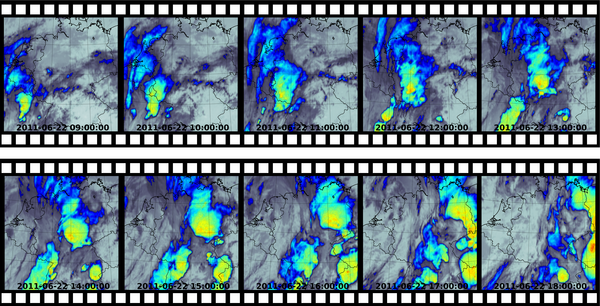
Spatio-temporal Characterization of Clouds, Aerosols and Radiation
Satellite and additional data are used to improve the understanding of atmospheric processes and to investigate life cycles of clouds and their interaction with aerosols and radiation. The improved understanding is utilized for the evaluation of atmospheric models.

Current Research Topics
Our working group currently deals with the following research topics:
- Integrating ground-based and spaceborne cloud observations to characterize frontal cloud systems The realistic representation of cloud processes is still a big challenge for atmospheric research. The most accurate observations are currently performed at a few number of supersites worldwide (e.g. LACROS). To enable the comparison of ground-based vertical cloud profile with satellite measurements we have developed a methods based on radiative transfer modeling. The main result is a merged data set of micro- and macrophysical cloud properties considering two perspectives, from ground and space. Based on this method we study the temporal evolution of frontal cloud systems.
- Evaluation of atmospheric models One focus of our research group is the evaluation of regional weather prediction models by using Meteosat data. The Meteosat imager has a horizontal resolution similar to the resolution of regional models and thus is suitable for comparison with them. We apply an object based method to verify model predicted summer convection. Additionally, the uncertainties of synthetic satellite images are analyzed in order to evaluate mineral dust forecasts.
-
Mobile shipborne observation of aerosol optical properties: With a multispectral radiometer (GUVis-3511) the spectral, downward, global irradiance at 19 wavelengths between 300nm and 1700nm get observed. The applied dynamic shadow-band provides a huge increase of functionality for the radiometer. Thus one can split the downward global irradiance in its direct and diffuse part and observe optical properties of aerosol in the atmosphere with a single sensor. The instrument is integrated in the OCEANET platform. [link GUVis and OCEANET Website; cite Witthuhn2017 and Witthuhn 2020]
-
Simulation of cloud and aerosol radiative effects: To investigate radiative effects of clouds and aerosol particles, a Python-based framework to carry out radiative transfer simulations is developed. T-CARS (TROPOS - Cloud and Aerosol Radiative effect Simulator) is based on 1D radiative transfer models and is designed to receive input data from a variety of sources, such as CloudNet [https://www.tropos.de/en/research/projects-infrastructures-technology/coordinated-observations-and-networks/cloudnet], reanalysis datasets, satellite and ground-based observations. [cite Barlakas 2020, Witthuhn 2021, Barrientos 2021]
-
Cloud Regime variability over Europe: MSG SEVIRI cloud optical properties from the CLAAS-2.1 data record are used as a basis for deriving cloud regimes over Europe by applying the K-means clustering algorithm. The spatiotemporal variability of the cloud regimes at various scales is examined along with differences to existing global cloud regime climatologies. Additionally, associations between the derived cloud regimes and large scale weather patterns are studied by comparing to the Objective Weather Type Classification.
-
Life cycles of shallow cumulus cloud fields: Our aim is to characterize the life cycles of shallow cumulus clouds fields from formation to dissipation. Suitable tracking methods are used to study the evolution of these cloud fields in a Lagrangian perspective. We apply several satellite retrievals to calculate their physical and geometrical cloud properties. Estimated statistical parameters like the horizontal cloud size distribution and mean cloud field life times are compared with high resolution model output.
-
Initiation and growth of deep convective clouds: The initiation and growth of deep convective clouds is driven by a complex interaction of different parameters (e.g. uplifting processes, inversion layers, available moisture) that can cause mature thunderstorms. By using Meteosat data we investigate the dynamical and micro-physical properties of growing clouds during their life cycles to improve the understanding of initiation mechanisms.
- Micro-physical properties of mature storms and their connection to lightning and hail events The temporal evolution of mature storms is quantified by a synergistic analysis of precipitation radar, lightning detection and derived cloud properties from satellite data. Indicators and predictors for the thunderstorm intensity are analyzed.
